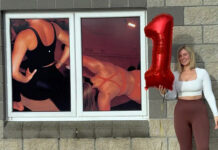
by John Arnold
Bartholomew (Batt) Dorgan was born at Shanavougha, Kildinan October 9th, 1883. His parents were John Dorgan and Mary Murphy. In June 1913, Batt married Abina O’Connell daughter of Patrick O’Connell and Mary Murphy of Cooliney, Ballyhooly. Batt Dorgan farmed the ancestral acres at Shanavougha.
He was born the year before the GAA was founded and grew up during the Land War Years. He lived through historic times including the First World War, the Irish War of Independence and Civil War and World War II. He had a great interest in his roots and locality and in 1967, he wrote the following article on local history. Batt Dorgan died in 1978 at the age of 94.
KILDINAN – A HISTORY
‘Kildinan (Cill Daighneain) or Dinan’s church comprises the western portion of the Parish of Rathcormac and the Eastern part of the parish of Glenville, the centre of which is Kildinan School in North East Cork.
It is essentially a rural community, typically Gaelic, industrious people, who have always had a keen interest in athletic sports. The potato crop is the principal crop as the black soil of the district is eminently suitable for this crop and in 1924, the first certified seed potatoes grown in county Cork were grown in the district, ten Kildinan farmers pioneering the certified seed industry and since that year, Cork Certified Seed Potatoes have had an excellent reputation.
The brothers, William and Con Phibbs, were athletes of international fame. The Phibbs family came to reside in Kildinan in 1872. Bill Phibbs created a sensation when, only a lad of sixteen years, he won a point-to-point race at Knockanard, Fermoy riding bareback.
He won his first half-mile flat race at Rathcormac Sports in 1895. The sports were held in Lisnagar Park. In 1887, Bill broke the Irish record for the half-mile flat. He had the distinction of being a member of the Irish Athletic Invasion Team which toured the USA in 1888.
Con was six years younger than Bill and was an all-round athlete and jumper. In 1896 he joined the Cork City Harrier Club and was a member of the club’s team which won the ten miles senior cross country championship of Ireland in Dublin, in the following year. Con Phibbs being the individual winner.
Con emigrated to England in 1913. He joined the independence movement, was arrested in 1916 and tried for high treason, being sentenced to fifteen years penal servitude. He was released in 1922 after serving six years of his sentence. He found himself without work and had no resources.
In his own words: “I had not a shirt on my back, a boot on my foot or a penny in my pocket”. He was befriended by some of the comrades who had suffered imprisonment with him and returned to Dublin where he secured employment in the Post Office through the good graces of the late Mr JJ Walshe, who was then Minister for Posts and Telegraphs. He died in St Kevin’s Hospital, Dublin in 1949.
Mr Sean O’Duffy and others of his comrades who had been fellow prisoners of Con’s, accompanied his remains to the family burial plot in Glanworth Cemetery where the late Willie Barry of Ballylegan, Glanworth and the late Liam Riordan, NT Glanworth superintended the burial arrangements. The Phibbs Memorial committee have since erected a memorial stone to the Phibbs brothers in Glanworth Cemetery and his was unveiled by Mr. Sean O’Duffy in 1950.
In this centenary year of the Fenian Rising, it is interesting to recall that Peter O’Neill Crowley and some of his comrades called to the farm yard of the writer’s father on their way to Kilclooney Wood. The writer’s father, with two helpers, were threshing corn with flails when the Fenians called and O’Neill Crowley said they were heading for Kilclooney.
They put down their guns and worked the flails for a short time. The dinner which was ready for the three men was given to the Fenians. They forded the Blackwater at Renny, Ballyhooly and called to Con McDonnell’s of Kilcummer where they had refreshments. In Kilclooney Wood, next day, Peter O’Neill Crowley gave his young life for Ireland.
During the War of Independence many young men from the Kildinan district played a prominent part. The Dalys of Bushypark made a dramatic escape from Fermoy Barracks while under sentence of death. Another to play a very prominent part in the fight was Liam Dorgan of Glenagoul.
In 1919 when the Republican Courts took over the administration of justice, the writer was appointed a justice and the first republican court to sit in North East Cork was held at Geragh, Kildinan, in the house now occupied by Mr. John Joyce. All the men who constituted the court have now passed to their eternal reward except Pat O’Connor, Ballybrowney who acted as court clerk and the writer.
In the last decade of the nineteenth century Kildinan produced some first class hurlers who played with the famous Bartlemy team. Amongst the most prominent were “Big” Patsy Murphy and “Little” Patsy Murphy.
In later times Kildinan had a strong athletic club which won numerous trophies and in 1941 a member of the club, Dan Murphy, became four mile champion of Munster whilst in 1942 another member, James Hickey, became three mile walking champion of Munster. In the following year, the club fielded a junior cross country team, captained by George Gubbins, which succeeded in winning the junior cross country championship of Ireland over a distance of six miles. This was indeed a wonderful achievement for such a small district.
Jim Murphy of Raheen, son of “Big” Patsy Murphy was a very good long distance runner being winner of several trophies as well as being a hurler of no mean ability. With his brother Bill, the Collins of Mullintoura and Denny O’Leary of Bridestown, he helped the local team, Bride Rovers, to win two East Cork junior A hurling championships in the 1930s.
Through the years, Kildinan has had the reputation of being one of the best shooting districts in County Cork.
It has also been the happy hunting ground of several hunt clubs, as well as being the haunt of anglers who enjoy the fishing for salmon and brown trout in the North Bride, which flows through the district.’







